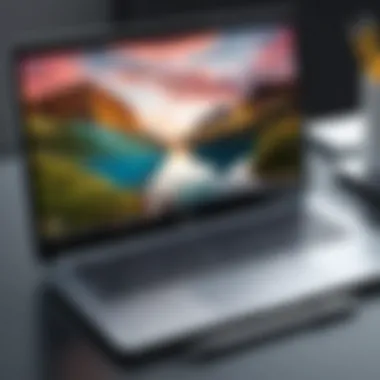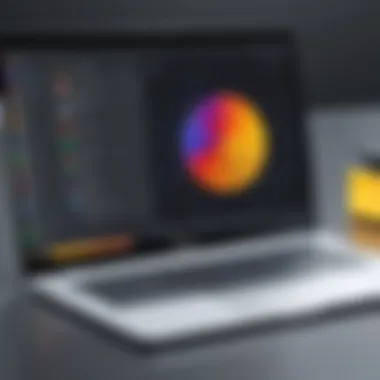Edit Screen Recordings on Chromebook: A Complete Guide


Intro
In the digital age, screen recordings have become invaluable for numerous activities. Whether it's for educational purposes, gaming streams, or business presentations, capturing and editing these recordings can elevate content quality significantly. For users on a Chromebook, the process may seem daunting due to the device's unique operating system. However, with the right tools and methods, editing screen recordings on a Chromebook can be a smooth, user-friendly experience.
This guide aims to demystify that process. We will explore various tools tailored for Chromebook users, offering insights into how each solution can cater to different editing needs. Additionally, we'll provide practical tips that streamline the editing journey, ensuring that even the most novice users feel confident in their ability to produce polished final products. Let's dive in!
Prolusion to Screen Recording on Chromebook
In the digital era, screen recording has become more than just a niche skill reserved for tech experts. With the rise of content creation, online education, and virtual collaboration, being able to capture and edit screen recordings efficiently is invaluable. For Chromebook users, this capability not only enhances communication but also opens doors to creative expression and streamlined workflows.
Understanding Screen Recording
Screen recording refers to the process of capturing the activity occurring on a computer screen. It's like taking a snapshot but in motion, allowing users to show exactly what's happening in real-time. Chromebooks, which run on Chrome OS, have built-in support for screen recording, making them convenient for those who want a straightforward way of documenting their screen's activities.
Understanding how screen recording works on a Chromebook involves grasping a few key concepts:
- Built-in Features: Chrome OS offers native screen recording tools that are easy to access and use. Users can record entire screens or select specific windows depending on their needs. This feature is particularly handy for educators wanting to create tutorial videos or for professionals needing to share presentations.
- Accessibility: The tools are often just a couple of clicks away, ensuring that users, regardless of their technical skill level, can engage in screen recording without much hassle. Accessibility is vital as it allows a broader audience to create content, share ideas, or capture important on-screen moments.
- File Management: Once a screen recording is done, managing the resulting files is crucial. Chromebooks typically save these files in an easily navigable location, allowing users to find and edit them without much trouble.
In essence, screen recording transforms a Chromebook into a dynamic tool for education, professional sharing, and personal expression. Knowing how to leverage this function speaks volumes about one’s ability to adapt in a tech-centric environment.
Importance of Editing Screen Recordings
Once a screen recording is captured, editing becomes a necessary next step in ensuring that the final product effectively conveys its intended message. The importance of editing cannot be overstated; raw footage, while informative, often requires refinement to achieve clarity and engagement.
Here are several reasons why editing screen recordings is so essential:
- Enhanced Clarity: Editing allows for the removal of unnecessary or confusing parts, keeping the viewer focused on the core message. This is especially important in educational content where getting to the point matters.
- Improved Engagement: A well-edited video holds the audience's attention better than one filled with interruptions or irrelevant information. By trimming the fat, users can create a smooth flow, making it easier for others to absorb and retain information.
- Professionalism: Edited recordings tend to look more polished and credible, enhancing the creator's reputation. In professional settings, this can make a significant difference in how the content is perceived, reflecting competence and care.
- Tailored Messaging: The ability to manipulate the audio and visual elements gives users the chance to tailor their message to their audience effectively. Whether it's adding text annotations for emphasis or incorporating background music for mood, editing allows users to express exactly what they want to convey.
Overall, screen recording and editing on Chromebooks is a powerful combination that can lead to high-quality content creation. This capability isn’t just about capturing information; it’s also about making that information accessible and engaging to a wide audience.
Getting Started with Screen Recording
When it comes to editing screen recordings on your Chromebook, understanding the basics of how to start recording is paramount. This section sets the stage for what’s to follow, focusing on why getting started effectively impacts the quality of your final edited product. Not all recordings are created equal, and the foundational settings and features you choose will heavily influence the editing process later on.
Establishing a grasp of screen recording capabilities helps you capture engaging content, whether that be tutorials, presentations, or gameplay. You can’t edit what you don’t have, and thus, the first step in this journey is activating the right tools and settings on your device.
Activating Screen Recording Features
To kick things off, it’s essential to activate the screen recording functions on your Chromebook. This is often straightforward, but it’s worth familiarizing yourself with the steps. Here’s how you can get the ball rolling:
- Access the Quick Settings Menu: Click on the time indicator in the bottom right corner of your screen. This will pull up various settings.
- Select Screen Capture: Within the menu, look for the option labeled Screen Capture or something similar. It should have an icon that looks like a camera or a screen.
- Choose Your Recording Option: You’ll likely need to decide between capturing the entire screen or just a portion. This flexibility can be crucial, depending on your project’s needs.
By activating these features, you set yourself up for a successful recording experience. Remember, having these tools at your fingertips allows for spontaneity and creativity when inspiration strikes.
Recording Settings and Options
Once you've activated the necessary screen recording features, the next piece of the puzzle involves diving into the specific settings and options available to you. Every detail counts, and the right settings can lead to a considerably polished final output. Here are a few key components to pay attention to:
- Resolution Preferences: Higher resolutions deliver sharp visuals, perfect for detailed tutorials, but pay attention—recording in ultra-high definition can consume more storage.
- Audio Capture Settings: Be mindful of whether you need to include internal audio (for instance, sounds from games or apps) or record voiceovers. Adjusting this setting beforehand is crucial for clarity later.
- Frames Per Second (FPS): If you want your video to move smoothly, aim for a higher frame rate. This is especially important for dynamic activities like gaming.
Getting these settings right ensures that your screen recording aligns with your vision. No one desires to sit through a shaky video or one where important sound cues are lost. It's the attention to detail here that can really elevate your editing experience and, ultimately, your final product.
Choosing the Right Editing Software
Selecting the appropriate editing software for screen recordings is crucial for achieving professional results. The right tool can enhance the quality of your output, streamline your workflow, and ensure that your content resonates with your audience. With several options available, ranging from built-in editors to third-party applications and web-based solutions, users must navigate the landscape carefully to find what best suits their needs.
Comparing Available Editing Tools
Built-in Editors
Built-in editors often come as part of the operating system or pre-installed software on your Chromebook. These tools are typically lightweight and user-friendly, making them an appealing choice for those who are just getting started with video editing. A key characteristic of built-in editors is their integration with the device, allowing for quick access without any additional installations.
The unique feature here is simplicity. Many users appreciate how these editors offer basic functions like trimming and merging clips without the bells and whistles that can sometimes complicate the process. However, the disadvantage might be limited capabilities—if you need advanced features like advanced audio editing or special effects, built-in options might leave you wanting more.
Third-party Applications
When it comes to versatility and features, third-party applications shine. These tools provide a broader array of options, from detailed color correction to extensive audio editing capabilities. A principal advantage is customization, which appeals to serious editors looking to refine their videos down to the last nitty-gritty detail.


An example could be apps like Kdenlive or OpenShot, known for their robust features. However, one must consider that with such depth often comes a steep learning curve. While these editors empower you to create more complex projects, they can be intimidating for novices, and some may also require a more powerful device than a standard Chromebook.
Web-based Solutions
Web-based solutions offer the benefit of accessibility. As long as you have a reliable internet connection, you can edit your videos from anywhere—a huge plus for on-the-go users. Tools like WeVideo or Clipchamp allow for seamless collaboration, making them especially valuable in team settings.
A standout feature is cloud storage; your projects are saved online, ensuring you won’t lose your work if something goes amiss with your device. That said, the limitations could include reliance on internet speed which may hinder performance at times.
Factors to Consider When Selecting Software
When selecting editing software, various factors must guide your decision to ensure it aligns with your specific needs and preferences.
User Interface
The user interface (UI) plays a pivotal role in your editing experience. A clear and intuitive UI can save you heaps of time and frustration. A simple drag-and-drop interface, for instance, allows for smoother editing workflows. If the layout is cluttered or not user-friendly, it may end up being more of a hindrance than a help.
Some editors are designed specifically with beginners in mind, making them easier to navigate. However, the drawback could be that they lack the depth needed for advanced users; their features may seem rudimentary if you’re aiming for more intricate edits.
Features
The range of features available in editing software can vary significantly. A comprehensive suite often includes tools for color correction, audio mixing, and special effects, which can add depth and polish to your recordings. This variety is particularly important for content creators looking to differentiate their work in a saturated market.
Still, having too many features can sometimes complicate the process. Users may find themselves overwhelmed. Therefore, ensuring the software has the features that specifically align with your editing goals is key.
Cost
Finally, cost is an essential consideration. Free software might sound tempting, but they often have limitations regarding functionality and watermarks on exports. Conversely, subscription-based models can offer robust professional tools, but they may not be feasible for everyone.
Weighing the benefits against the cost involves considering how often you will use the software and how much you're willing to invest in your editing journey.
In summary, each of these factors—UI, features, and cost—affects how well the software meets your needs in editing screen recordings. Doing thorough research upfront can save a lot of headaches later, ensuring you choose a tool that complements your skill level and editing ambitions.
Basic Editing Techniques
Editing plays a vital role in turning raw screen recordings into polished, engaging content. When using a Chromebook for screen recording, understanding basic editing techniques can significantly enhance the quality of your videos. These techniques not only help refine your footage but also ensure that the message you're trying to convey is delivered clearly and effectively. Here, we'll delve into two essential editing methods: trimming clips and splitting and merging videos.
Trimming Clips
Trimming clips is often the first step in the editing process, and it’s a lot more than just chopping off the beginning or ending of a video. It’s about ensuring that every second counts. Removing unnecessary parts can help maintain viewers’ attention, making your content more focused and engaging.
Imagine you’ve recorded a tutorial that starts with a lengthy setup or an accidental pause - a viewer might click away within those first few seconds. By trimming your clips, not only do you streamline your content, but you also eliminate distractions, creating a more professional appearance.
To trim clips on your Chromebook, you might use built-in tools like the Google Photos or third-party applications. Each tool has its own interface and functionality, but the fundamental process is similar:
- Upload your screen recording to the chosen tool.
- Select the trim option where you can set your desired start and end points.
- Preview the trimmed clip to ensure everything looks good.
- Save the changes and export your edited video.
In short, this seemingly simple action can drastically improve your video’s quality. After all, who wants to wade through the nonsense?
Splitting and Merging Videos
Now, let's journey into splitting and merging videos. This technique can be particularly useful when you want to rearrange segments of your footage or combine multiple recordings into one cohesive video. For instance, if you captured a lengthy session on different topics, splitting those recordings into specific segments allows you to highlight each section separately, making them easier for your audience to digest.
Merging, on the other hand, can be your best pal when you want to combine clips from different recordings into a single, fluid narrative. Say you’ve created a video showcasing various steps in a troubleshooting guide. By merging these clips, you create a seamless flow that guides viewers from start to finish without interruption.
Here’s how to split and merge videos using Chromebook-friendly tools:
- Import your video clip into your editing software.
- Use the split tool to isolate segments that need separate attention.
- Rearrange clips by dragging them into your desired order.
- Select merge or combine, depending on the software you use, to finalize the new compilation.
The ability to split and merge videos encourages creativity. You can create streamlined tutorials, engaging vlogs, or any other type of content that resonates with your intended audience. In this digital age, where attention span is fleeting, utilizing these basic editing techniques can keep your viewers engaged and eager for more.
"Editing is the process of selection and organization – it's how you tell your story."
Each technique fuels the next, ensuring your finished product isn’t just another video but a carefully crafted piece of content that reflects your purpose and intent.
Advanced Editing Features
In the realm of video editing, particularly when it comes to screen recordings made on Chromebooks, having advanced editing features can elevate a simple clip into a polished presentation. These enhancements are not merely luxuries; they are essential tools that can transform a casual recording into a professional-looking tutorial or review. Advanced editing capabilities cater to a variety of needs, whether you're producing educational videos, sharing gameplay highlights, or crafting tutorials for software applications.
Advanced features enable users to tailor their videos in ways that speak directly to their audiences. By customizing clips with annotations, effects, and background music, editors can effectively emphasize key points while simultaneously keeping viewers engaged. Here are some significant elements to consider:


- Precision: Advanced editing allows for precise control over video elements. Whether it’s fine-tuning transitions or carefully timing text overlays, this precision enables a polished final product.
- Engagement: Viewers are more likely to stay interested in a video that presents information in an engaging manner. Videos enriched with effects, sounds, and annotations hold viewers' attention better than straightforward recordings.
- Brand Identity: For content creators, integrating a unique style through specific editing features can greatly enhance brand identity. Custom animations or consistent color schemes make videos instantly recognizable.
Now, let’s explore some specific advanced editing techniques that can make your screen recordings stand out.
Adding Annotations and Text
When editing screen recordings, integrating annotations and text is crucial for clarifying content and guiding viewers through your presentation. They serve as visual aids, directing attention to specific areas of the screen or providing additional context to what’s being discussed. Here are some key considerations for using annotations and text effectively:
- Relevance: Every annotation should support the content it accompanies. Irrelevant text can confuse viewers rather than help them.
- Timing: Text should appear long enough for viewers to read but not so long that it distracts from the video. Careful timing can turn a simple note into an effective teaching tool.
- Style: Consider font choices and color schemes that align with your video’s overall aesthetic. This may help to maintain a professional appearance throughout.
Creating engaging annotations can be as simple as including a brief highlight on major points, or as complex as utilizing full-fledged graphics. The trick often lies in balancing information with simplicity.
Incorporating Background Music and Sound Effects
Background music and sound effects are not just extras but are key ingredients that lend a certain dynamism to your videos. When chosen and implemented thoughtfully, these audio elements can enhance the viewing experience in several ways:
- Setting the Atmosphere: Upbeat music can energize a tutorial, while softer sounds can set a calm, focused tone for instructional videos. Matching sound with content mood makes for a more cohesive experience.
- Emphasis: Sound effects can serve to accentuate important points. For instance, using a chime for key announcements can signal to viewers that something significant is happening.
- Transitions: Music during transitions keeps the momentum flowing smoothly. Seamless transitions preserve viewer engagement and create a more polished feel.
When you set out to add background music or sound effects, consider the following:
- Volume Control: Ensure that your music levels don't overpower your narration or main audio. Finding that sweet spot can make all the difference.
- Licensing: Be wary of copyright issues. Utilize royalty-free music when possible to avoid any legal complications It’s prudent to explore various platforms offering such resources.
Incorporating these advanced techniques opens the door to endless possibilities for enhancing your screen recordings. While it may seem daunting at first, experimenting with these features will certainly develop your editing skills and lead to more professional results.
Exporting and Sharing Screen Recordings
When it comes to screen recordings, the journey doesn't end with just capturing the material. Exporting and sharing those recordings plays a significant role in ensuring that the content reaches the intended audience effectively. Properly exporting the video files allows users to maintain quality, while sharing options determine how, where, and to whom the content is distributed. Ignoring this aspect can lead to missed opportunities for engagement and connection. Therefore, understanding the nuances of what formats to use and how to share them can truly amplify the impact of your work.
Choosing the Right Format
Think of the format as the very vessel that holds your video content. You wouldn’t want to send a fine wine in a soda can, would you? The format you choose will impact the quality, size, and compatibility of your screen recording. Common formats include MP4, AVI, and MOV, each with its own strengths and weaknesses. MP4 enjoys widespread popularity because it balances quality and file size, making it ideal for most platforms. AVI might offer better quality but at the cost of larger file sizes, which can be cumbersome for sharing online. Meanwhile, MOV files, often used by Apple's software, could have compatibility issues with some devices and platforms.
Sharing Options Available
Once you have the right format nailed down, it’s time to share your creation. There are various options to do this, catering to different needs and audiences. Here’s a closer look:
Social Media
Social media platforms like Facebook, Twitter, and Instagram offer a quick way to get your content out there. The key characteristic of social media is immediacy. Once your video is uploaded, it can be seen by your followers almost instantly. This immediacy is a powerful attribute, especially for engaging with audiences in real-time. However, the unique feature of social media sharing lies in its ability to foster interaction. Viewers can comment, like, and share further, expanding your reach almost organically. One downside is that some platforms compress videos, which might reduce quality, so it’s something to be wary of.
Cloud Storage
Cloud storage options like Google Drive and Dropbox provide a secure way to manage and share your screen recordings. The key advantage of cloud storage is accessibility. You can quickly access your files from any device with an internet connection. It's super handy for collaboration, too—if you’re working in a team, sharing your recordings via a cloud service allows others to give feedback or work on the files without hassle. On the flip side, storage limits can be a concern if you’re dealing with larger video files, and uploading time can be lengthy, depending on your internet speed.
Direct Downloads
Direct downloads can be one of the simplest methods of sharing recordings, particularly for more private or targeted audiences. By allowing users to download the file directly from a webpage or an email, you maintain full control over how your content is delivered. This aspect can be very beneficial when dealing with professional or academic settings where high quality is paramount. However, unlike social media, direct downloads lack broader exposure. It's ideal for sharing with a limited audience but may not create the same level of engagement seen on social platforms.
The method of sharing your screen recordings can greatly influence how your audience perceives and engages with your content.
Troubleshooting Common Editing Issues
Editing screen recordings can sometimes feel like navigating a minefield. Even the most straightforward processes can hit a snag or two, leaving users scratching their heads. This is where it’s crucial to address common editing issues, as knowing how to troubleshoot them can save time and preserve the integrity of the work you put into your videos. A well-edited video reflects not just quality content but also the skill and effort behind it. Let’s dive into two frequent hurdles you might encounter while editing your screen recordings on a Chromebook.
Audio Sync Problems
Audio sync issues are an all-too-common headache for anyone who records and edits video. Imagine going to the effort of recording a flawless tutorial, only to find that the voiceover doesn’t match the visuals. It’s like watching a bad dub of a movie; wholly distracting.
The root of the problem often lies in the settings. If the recording settings aren't configured correctly, the audio and video tracks can drift apart. To tackle this, follow these simple steps:
- Check Your Recording Settings: Before you hit that record button, ensure that the audio settings match the video frame rate. Mismatched settings can lead to sync issues right from the start.
- Adjust in Editing Software: Most editing tools come equipped with features that allow you to align audio with video. Dragging the audio track slightly can sometimes be the quick fix you need.
- Use Dedicated Software Tools: If you notice this issue frequently, consider dedicated video tools that have better capabilities for managing audio tracks, such as adjusting latency and syncing options. Tools like Kdenlive or Shotcut offer these functionalities and can make life a lot easier.
File Format Incompatibilities
File format complications can pop up at the most inconvenient times, often leaving you grappling with a sense of urgency as deadlines loom. Sometimes, you think you’ve handpicked the best software for your editing, only to discover it won’t accept your video format.
Here are some pointers to navigate the stormy waters of file conversion and format issues:
- Know Your Formats: Familiarize yourself with common formats such as MP4, AVI, and MOV. Knowing what your chosen editing suite can handle can save you from unnecessary frustration.
- Convert When Necessary: If you find yourself stuck with an incompatible format, tools like HandBrake are lifesavers. They help convert your files swiftly without losing quality, letting you jump back into editing swiftly.
- Keep an Eye on Quality: When converting files, always double-check that the quality settings match your desired output. No one wants to deliver a low-resolution video after all that hard work!
Pro Tip: Backup your recordings in a universally accepted format, like MP4. It simplifies compatibility issues later.
Troubleshooting these common issues isn't just about fixing problems as they arise; it’s about creating a smoother workflow for future projects. By knowing the common pitfalls, you can save not only time but also maintain the quality of your output.


Best Practices for Editing Screen Recordings
Editing screen recordings effectively can elevate the quality of your content significantly. Following best practices not only saves time but also ensures that the final product is polished and engaging. This section will dive into essential strategies that can help anyone make the most out of their screen recordings on a Chromebook.
Planning Your Edits
Before pressing that edit button, it’s wise to lay out a plan. Think of it as drafting a road map for your journey. Knowing what you want to achieve with your screen recording helps guide your editing process.
Start by asking yourself these questions:
- What’s the main purpose of this recording? Are you aiming to educate, entertain, or inform?
- Who’s your audience? Tailoring your edits to suit your viewers can make a world of difference.
- What key points do you want to highlight? Identifying the highlights beforehand can assist in trimming down unnecessary content.
Once you have this figured out, take notes. Write down timestamps for essential moments you want to feature. This might sound trivial, but it can save you time scrolling through endless footage. It’s like having a treasure map; the X marks the spot!
Keeping It Engaging and Informative
An edited screen recording should not just be a tidy video; it ought to keep viewers hooked. To achieve this, consider incorporating elements that increase engagement, while also ensuring that information remains intelligible.
Here are a few tips for maximizing engagement:
- Use visuals wisely: Add annotations or graphics that complement the spoken content; too much, and it might confuse, too little, and it risks being dull.
- Pace your cuts: Maintain a rhythm. Quick cuts can energize the content, while longer segments give viewers time to digest key information.
- Vary your media: Don’t hesitate to integrate different forms of content—like audio clips, screenshots, or video inserts—to keep it fresh.
Ultimately, aim for a cohesive narrative that provides value and clarity. Make sure that each segment serves a purpose; if something feels redundant, it likely doesn’t belong.
"Creating engaging content is like cooking; a blend of good ingredients usually serves up something delicious."
To conclude this section, remember that successful editing blending planning with creativity can make your screen recordings on a Chromebook not just functional, but truly captivating.
Resources for Further Learning
In the world of technology, the ability to adapt and learn continuously is paramount. When it comes to editing screen recordings on a Chromebook, having access to reliable resources can significantly enhance your skills and confidence. Learning doesn't stop once you've finished this guide; it’s only the tip of the iceberg. This section sheds light on the various avenues available for expanding your knowledge and mastering the nuances of screen recording and editing.
As you explore these resources, consider aspects such as usability, depth of information, and the potential for hands-on practice. This will not only help you refine your skills but also keep you updated on the latest trends and tools available for screen recording.
Online Tutorials and Courses
The internet is a treasure trove of information. There’s no shortage of online tutorials and courses that cater specifically to users who want to elevate their screen recording editing game on Chromebooks. Websites like Udemy and Coursera offer extensive courses, ranging from the basics to advanced techniques. One thing to keep in mind is to look for courses with good reviews. A solid tutorial often covers not only technical skills but also provides context, examples, and practical exercises.
Here are a few platforms you might consider:
- YouTube: Many content creators host free tutorials that can be helpful for visual learners.
- LinkedIn Learning: Offers structured courses and certificates if you need something more formal.
- Skillshare: While it has a subscription, there’s a wealth of creative courses available, including video editing techniques.
Many of these platforms also encourage community interaction, allowing users to ask questions or provide feedback.
Community Forums and Help Centers
Engagement with other users can be incredibly illuminating. Community forums and help centers serve as a great resource for troubleshooting and learning from others’ experiences. Platforms like Reddit have dedicated subreddits where technology enthusiasts discuss strategies, share tips, and troubleshoot common issues.
Additionally, visiting help centers of the editing tools you choose, like WeVideo or Screencastify, often yields valuable guides, FAQs, and user forums. These spaces allow for:
- Real-time problem solving: A forum can provide immediate answers to your queries.
- Shared experiences: Users share their own edits, offering inspiration and lessons learned.
- Networking: Connecting with like-minded individuals can forge friendships and collaborations.
"A problem shared is a problem halved"—find your community, and you’ll be amazed at how much easier editing becomes.
By leveraging these resources, you'll be better prepared to tackle challenges and enhance your screen editing skills. Remember, the journey of learning is ongoing; staying engaged is key.
Culmination: Mastering Screen Editing on Chromebook
Screen editing on a Chromebook is not just about cutting and pasting clips together; it’s about transforming raw recordings into polished pieces that convey your message effectively. By mastering these editing tools and techniques, users can ensure that their content stands out in a crowded digital landscape. This section serves as the final piece of our comprehensive guide, encapsulating key strategies and insights that will enhance your editing endeavors.
Recap of Key Takeaways
As we wrap up, let's stroll back through the crucial elements we discussed:
- Understanding Tools: The importance of choosing the right software can't be overstated. Whether it’s a built-in editor or a robust third-party application, your choice should align with your editing needs.
- Editing Techniques: Familiarizing yourself with basic techniques like trimming and merging strengthens your ability to create concise content that holds attention.
- Advanced Features: Incorporating features such as annotations and background music can elevate your video’s quality, making it more engaging and informative.
These elements form a framework that guides you every step of the way, ensuring that your final output not only looks professional but also communicates effectively.
Encouragement to Practice
Now that you’re equipped with the tools and tips, the next step is to roll up your sleeves and get to work. Experience is the best teacher. Start with simple projects, perhaps something as straightforward as editing a family video or a quick tutorial. The more you practice, the more you will unearth your unique editing style and preferences.
Remember, don’t shy away from trying new techniques. Dive into different styles, explore various software, and experiment with what works best for you. With each video you edit, you sharpen your skills further and bring your creative vision to life.
In the bustling world of content creation, consistency and improvement are key. You’ve got this — now go and make your recordings shine!



